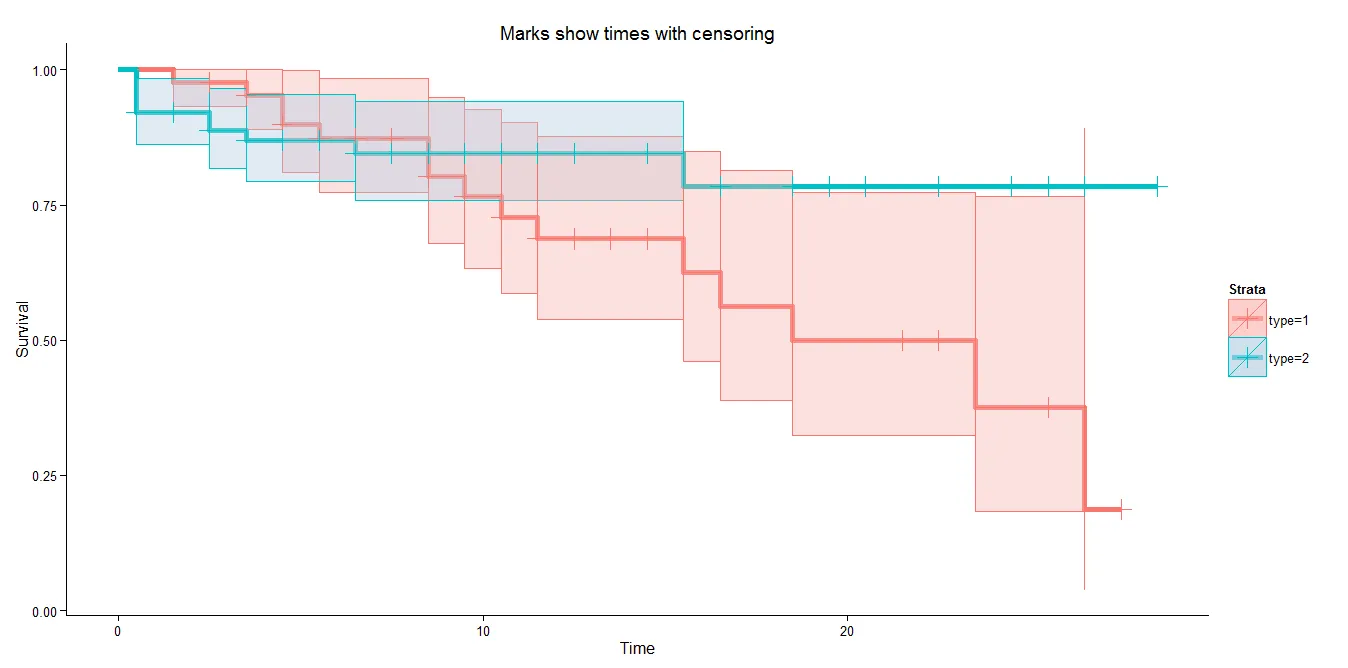我一直在寻找使用ggplot2绘制生存曲线的解决方案。我找到了一些不错的例子,但它们并没有遵循整个ggplot2美学(主要是关于阴影置信区间等方面)。因此,最终我编写了自己的函数:
ggsurvplot<-function(s, conf.int=T, events=T, shape="|", xlab="Time",
ylab="Survival probability", zeroy=F, col=T, linetype=F){
#s: a survfit object.
#conf.int: TRUE or FALSE to plot confidence intervals.
#events: TRUE or FALSE to draw points when censoring events occur
#shape: the shape of these points
#zeroy: Force the y axis to reach 0
#col: TRUE, FALSE or a vector with colours. Colour or B/W
#linetype: TRUE, FALSE or a vector with line types.
require(ggplot2)
require(survival)
if(class(s)!="survfit") stop("Survfit object required")
#Build a data frame with all the data
sdata<-data.frame(time=s$time, surv=s$surv, lower=s$lower, upper=s$upper)
sdata$strata<-rep(names(s$strata), s$strata)
#Create a blank canvas
kmplot<-ggplot(sdata, aes(x=time, y=surv))+
geom_blank()+
xlab(xlab)+
ylab(ylab)+
theme_bw()
#Set color palette
if(is.logical(col)) ifelse(col,
kmplot<-kmplot+scale_colour_brewer(type="qual", palette=6)+scale_fill_brewer(type="qual", palette=6),
kmplot<-kmplot+scale_colour_manual(values=rep("black",length(s$strata)))+scale_fill_manual(values=rep("black",length(s$strata)))
)
else kmplot<-kmplot+scale_fill_manual(values=col)+scale_colour_manual(values=col)
#Set line types
if(is.logical(linetype)) ifelse(linetype,
kmplot<-kmplot+scale_linetype_manual(values=1:length(s$strata)),
kmplot<-kmplot+scale_linetype_manual(values=rep(1, length(s$strata)))
)
else kmplot<-kmplot+scale_linetype_manual(values=linetype)
#Force y axis to zero
if(zeroy) {
kmplot<-kmplot+ylim(0,1)
}
#Confidence intervals
if(conf.int) {
#Create a data frame with stepped lines
n <- nrow(sdata)
ys <- rep(1:n, each = 2)[-2*n] #duplicate row numbers and remove the last one
xs <- c(1, rep(2:n, each=2)) #first row 1, and then duplicate row numbers
scurve.step<-data.frame(time=sdata$time[xs], lower=sdata$lower[ys], upper=sdata$upper[ys], surv=sdata$surv[ys], strata=sdata$strata[ys])
kmplot<-kmplot+
geom_ribbon(data=scurve.step, aes(x=time,ymin=lower, ymax=upper, fill=strata), alpha=0.2)
}
#Events
if(events) {
kmplot<-kmplot+
geom_point(aes(x=time, y=surv, col=strata), shape=shape)
}
#Survival stepped line
kmplot<-kmplot+geom_step(data=sdata, aes(x=time, y=surv, col=strata, linetype=strata))
#Return the ggplot2 object
kmplot
}
我曾经使用for循环来处理每个层级的先前版本,但速度较慢。由于我不是程序员,因此寻求改进函数的建议。也许可以添加一个包含风险患者数据表,或更好地集成到ggplot2框架中。
谢谢。

